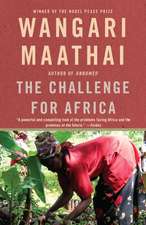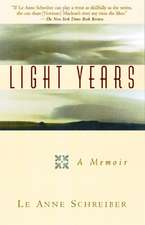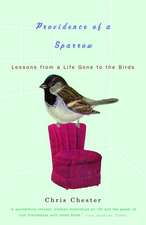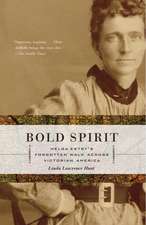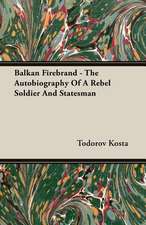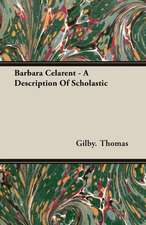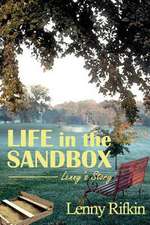Unbowed: A Memoir
Autor Wangari Muta Maathaien Limba Engleză Paperback – 31 aug 2007 – vârsta de la 14 până la 18 ani
Vezi toate premiile Carte premiată
Hurston/Wright LEGACY Award (2007)
Preț: 112.41 lei
Nou
Puncte Express: 169
Preț estimativ în valută:
21.51€ • 22.19$ • 17.95£
21.51€ • 22.19$ • 17.95£
Carte disponibilă
Livrare economică 05-19 martie
Preluare comenzi: 021 569.72.76
Specificații
ISBN-13: 9780307275202
ISBN-10: 0307275205
Pagini: 326
Ilustrații: 16 PP. B&W
Dimensiuni: 132 x 204 x 21 mm
Greutate: 0.39 kg
Editura: Anchor Books
ISBN-10: 0307275205
Pagini: 326
Ilustrații: 16 PP. B&W
Dimensiuni: 132 x 204 x 21 mm
Greutate: 0.39 kg
Editura: Anchor Books
Notă biografică
Wangari Muta Maathai was born in Nyeri, Kenya, in 1940. She is the founder of the Green Belt Movement, which, through networks of rural women, has planted over 30 million trees across Kenya since 1977. In 2002, she was elected to Kenya's Parliament in the first free elections in a generation, and in 2003, she was appointed Deputy Minister for the Environment and Natural Resources. The Nobel Peace Prize laureate of 2004, she has three grown children and lives and works in Nairobi.
Extras
Beginnings
I was born the third of six children, and the first girl after two sons, on April 1, 1940, in the small village of Ihithe in the central highlands of what was then British Kenya. My grandparents and parents were also born in this region near the provincial capital of Nyeri, in the foothills of the Aberdare Mountain Range. To the north, jutting into the sky, is Mount Kenya.
Two weeks into mbura ya njahi, the season of the long rains, my mother delivered me at home in a traditional mud-walled house with no electricity or running water. She was assisted by a local midwife as well as women family members and friends. My parents were peasant farmers, members of the Kikuyu community, one of forty-two ethnic groups in Kenya and then, as now, the most populous. They lived from the soil and also kept cattle, goats, and sheep.
At the time of my birth, the land around Ihithe was still lush, green, and fertile. The seasons were so regular that you could almost predict that the long, monsoon rains would start falling in mid-March. In July you knew it would be so foggy you would not be able to see ten feet in front of you, and so cold in the morning that the grass would be silvery-white with frost. In Kikuyu, July is known as mworia nyoni, the month when birds rot, because birds would freeze to death and fall from the trees.
We lived in a land abundant with shrubs, creepers, ferns, and trees, like the mitundu, mukeu, and migumo, some of which produced berries and nuts. Because rain fell regularly and reliably, clean drinking water was everywhere. There were large well-watered fields of maize, beans, wheat, and vegetables. Hunger was virtually unknown. The soil was rich, dark red-brown, and moist.
When a baby joined the community, a beautiful and practical ritual followed that introduced the infant to the land of the ancestors and conserved a world of plenty and good that came from that soil. Shortly after the child was born, a few of the women attending the birth would go to their farms and harvest a bunch of bananas, full, green, and whole. If any of the bananas had ripened and birds had eaten them, the women would have to find another full bunch. The fullness expressed wholeness and wellness, qualities the community valued. Along with the bananas, the women would bring to the new mother’s house sweet potatoes from her and their gardens and blue-purple sugarcane (kigwa kia nyamuiru). No ordinary sugarcane would do.
In anticipation of the birth, the expectant mother would fatten a lamb that slept and ate inside her home. While the women were gathered the ritual foods, the child’s father would sacrifice the lamb and roast a piece of the flesh. The bananas and the potatoes would also be roasted and along with the meat and the raw sugarcane given to the new mother. She would chew small pieces of each in turn and then put some of the juice into the baby’s tiny mouth. This would have been my first meal. Even before breast milk, I would have swallowed the juice of green bananas, blue-purple sugarcane, sweet potatoes, and a fattened lamb, all fruits of the local land. I am as much a child of my native soil as I am of my father, Muta Njugi, and my mother, Wanjiru Kibicho, who was more familiarly known by her Christian name, Lydia. Following the Kikuyu tradition, my parents named me for my father’s mother, Wangari, an old Kikuyu name.
According to the Kikuyu myth of origin, God created the primordial parents, Gikuyu and Mumbi, and from Mount Kenya showed them the land on which they were to settle: west from Mount Kenya to the Aberdares, on to Ngong Hills and Kilimambogo, then north to Garbatula. Together, Gikuyu and Mumbi had ten daughters—Wanjiru, Wambui, Wangari, Wanjiku, Wangui, Wangeci, Wanjeri, Nyambura, Wairimu, and Wamuyu—but they had no sons. The legend goes that, when the time came for the daughters to marry, Gikuyu prayed to God under a holy fig tree, mËœugumo, as was his tradition, to send him sons-in-law. God told him to instruct nine of his daughters—the tenth was too young to be married—to go into the forest and to each cut a stick as long as she was tall. When the daughters returned, Gikuyu took the sticks and with them built an altar under the migumo tree, on which he sacrificed a lamb. As the fire was consuming the lamb’s body, nine men appeared and walked out of the flames.
Gikuyu took them home and each daughter married the man who was the same height as she was, and together they gave rise to the ten clans to which all Kikuyus belong. (Even though the youngest daughter, Wamuyu, did not get married, she did have children.) Each clan is known for a particular trade or quality, such as prophecy, craftsmanship, and medicine. My clan, Anjiru, is associated with leadership. The daughters made the clans matrilineal, but many privileges, such as inheritance and ownership of land, livestock, and perennial crops, were gradually transferred to men. It is not explained how women lost their rights and privileges.
For the Kikuyus, Mount Kenya, known as Kirinyaga, or Place of Brightness, and the second-highest peak in Africa, was a sacred place. Everything good came from it: abundant rains, rivers, streams, clean drinking water. Whether they were praying, burying their dead, or performing sacrifices, Kikuyus faced Mount Kenya, and when they built their houses, they made sure the doors looked toward it. As long as the mountain stood, people believed that God was with them and that they would want for nothing. Clouds that regularly shrouded Mount Kenya were often followed by rain. As long as the rains fell, people had more than enough food for themselves, plentiful livestock, and peace.
Sadly, these beliefs and traditions have now virtually died away. They were dying even as I was born. When European missionaries came to the central highlands at the end of the nineteenth cen- tury, they taught the local people that God did not dwell on Mount Kenya, but rather in heaven, a place above the clouds. The proper place to worship him was in church on Sundays, a concept that was unknown to Kikuyus. Nevertheless, many people accepted the missionaries’ worldview, and within two generations they lost respect for their own beliefs and traditions. The missionaries were followed by traders and administrators who introduced new methods of exploiting our rich natural resources: logging, clear-cutting native forests, establishing plantations of imported trees, hunting wild- life, and undertaking expansive commercial agriculture. Hallowed landscapes lost their sacredness and were exploited as the local people became insensitive to the destruction, accepting it as a sign of progress.
At just over 17,000 feet above sea level Mount Kenya towers over the central highlands. Although it straddles the Equator, it is topped by glaciers year round. Beholding Mount Kenya for Kikuyus and other communities that live around the mountain—Kambas, Merus, and Embus—must have been awe-inspiring. The story goes that the explorers Johan Ludwig Krapf and Johannes Rebmann, upon encountering the mountain in 1849, asked their guide, a member of the Kamba community, who was carrying a gourd, “What do you call that?” Thinking the two Germans were referring to the gourd, he replied, “It’s called kii-nyaa,” pronounced Kenya by the British. This became the name of the mountain and later the country.
Throughout Africa, the Europeans renamed whatever they came across. This created a schism in many Africans’ minds and we are still wrestling with the realities of living in this dual world. At home, we learned the names of mountains, streams, or regions from our parents, but in school we were taught the colonial names, deemed the “proper” names, which we had to use on our exams. The Aberdares, for example, known locally as Nyandarua, or “drying hide,” because of their shape, were named by the British in 1884 after Lord Aberdare, then the head of the Royal Geographical Society.
Naturally, it was many years before I was to understand the complexities of the period. I was born as an old world was passing away. The first Europeans had come to Kenya during the time of my grandparents, in the late 1800s. In 1885, Britain and the other “great powers” of Europe met at the Berlin Conference to formalize what was known as “The Scramble for Africa”—a thirty-year dash to lay claim to the entire continent. With the stroke of a pen on a map they assigned whole regions to the different powers and created completely new nations. In East Africa, Germany received Tanganyika, which later united with Zanzibar to become Tanzania. Britain acquired what became the Kenya colony and the Uganda protectorate. Prior to this superficial partitioning, many communities in Africa had identified themselves as nations, albeit micronations. The resulting countries brought these communities together in arbi- trary ways so that sometimes the new citizens of the post-Berlin nations perceived each other as foreigners. Some micronations found themselves stranded between two neighboring countries. The consequences of these divisions continue to haunt Africa.
My great-grandparents, whom I did not know, lived in a pre- European world. They would probably not have interacted with any other communities outside the central highlands, apart from the Maasais, who are pastoralists, herders of cows and goats. The Maasai traditional way of life required them to transverse the large plains to the west of the highlands, the vast grassland surrounded by ridges resulting from seismic activity that ripped apart the earth’s crust many millions of years ago. The “scar” stretches from Jordan to Mozambique, forming the Great Rift Valley.
At times, Maasais would raid Kikuyu villages, take away their cattle, and kill their young men, and the Kikuyus would do the same to the Maasais. But there were also times of truce, trade in the form of exchange of food, livestock, and land, and even intermarriage. These interethnic links helped cement ties between communities and foster peace. In Nyeri, mixed Maasai and Kikuyu blood was common and never viewed as a stigma. My mother had Maasai blood in her. Like her father, she was lithe, with high cheekbones and straight hair, characteristics more typical of Maasais than Kikuyus. We were told that my great-great-grandmother on my father’s side was a Maasai who was abducted during a raid. When she came to the highlands, she adopted Kikuyu customs and named her second son Muta, after her father. That name was eventually handed down to my father and, later, to my second son.
Throughout the nineteenth century, European missionaries crisscrossed Africa, clearing the way for Christianity. Almost immediately behind them came numerous explorers, adventurers, fortune seekers, and those in the service of the European powers prospecting for riches in Africa (both natural and human) to exploit. In Kenya, the British, perhaps because they did not want local people to receive competing Christian messages from denominations that were already contesting fiercely in Europe, subdivided the country and apportioned different areas to different denominations. Among the Catholics, many different orders were active in Kenya: the Consolata Missionary Sisters from Italy and the Holy Ghost Order and Loreto Sisters from Ireland. Most of the first missionaries in my area were Scottish Presbyterians and Italian Catholics.
The missionaries would generally do their work by visiting villages and attending to peoples’ health needs. They treated particularly stubborn conditions, such as gangrene or difficulties with childbirth, that could not be healed with local remedies like herbs and tree bark, and then established health centers. Initially, the missionaries would instruct small groups of adults in reading—only after they had converted to Christianity—but quite rapidly they established schools. I admire the missionaries’ patience and ingenuity in facilitating communication among people who did not understand one another’s languages. They did their work well.
The art of reading and writing must have hit people like lightning. It must have been extraordinary to them that lines and dots on a page or a slate when taken together could transmit a message that a person many miles away could receive. It must have seemed like a new form of magic that overshadowed what Kikuyus had known until then. Reading and writing fascinated them and they embraced it with a passion.
Before the arrival of the missionaries, Kikuyus and all the Kenyan communities had largely oral cultures. The ways they delivered a message or passed information included the use of drums, horns, shouting, or sending somebody. Among Kikuyus, one interesting form of message transmission and education was gichandi, which was made from a gourd. When you shook it, the beads on strings on the outside and the seeds and stones inside made music. As players or actors shook the gourd, they relayed riddles, proverbs, and other folk wisdom and information. These gourds were also inscribed with symbols and marks that represented a form of writing that these artisans would use for recitations and conveying information.
Ironically, the missionaries described such instruments in detail, but then encouraged the local people who had converted to Christianity to destroy them. Even as they trivialized many aspects of the local culture, including various art forms, they also recorded them and saved some of the artifacts, which now reside in European museums. I have heard that one of these gichandi is in a museum in Turin, Italy.
To consolidate their hold on their new territories in Africa, during the first decade and a half of the twentieth century the European governments encouraged people of European descent—among them South Africans, Australians, Canadians, Britons, Germans—to settle in their colonies. In Kenya, these settlers began arriving in increasing numbers and the British authorities gave them land in the highlands. The settlers found the highlands very attractive for the same reasons the local people do: the soil was fertile, debilitating diseases like malaria were absent, and it was neither too hot nor too cold—perfect weather.
The settlers received title deeds to most of the land in areas where they preferred to settle, near emerging city centers or regions that seemed promising for successful wheat, maize, coffee, and tea farming, and for grazing livestock. To make way for them, many people were displaced, including a large number who were forcibly relocated to the Rift Valley. Those who refused to vacate their land were transported by the British elsewhere.
By the 1930s the British had ensured that native communities, including Kikuyus, had been restricted to designated regions known as native reserves while their land was subdivided among the new arrivals. People within the native reserves were able to keep their land. Ihithe was in the Kikuyu reserve and my father owned land there. Some he had bought and some he inherited from his father, who purchased it when he migrated to Ihithe from Kahiga-ini, a village nearby. After both the First and Second World Wars, war veterans came to Kenya and received land—one of the ways the British government thanked them for defending the crown. By the early 1950s, about 40,000 settlers, most of them British, had moved onto about 2,500 farms in what became known as the “white highlands,” which included the hills outside Nairobi, the highlands of the central and western regions, and large tracts of grassland in the Rift Valley.
However, even after the arrival of missionaries and then the British administration, pockets of the old way of life persisted. Three of my grandparents never converted to Christianity, but I am informed that my mother’s mother was baptized on her deathbed. Their children, however, converted as adults, the first generation of Kikuyus to become almost wholly Christian. They must have been among the early converts of their generation, because when I was growing up, my uncle Kamunya, charismatic and progressive, was already a leader in the African Independent Church. This church embraced both Protestant and Catholic teachings as well as aspects of Kikuyu culture discouraged in the other two denominations.
From the Hardcover edition.
I was born the third of six children, and the first girl after two sons, on April 1, 1940, in the small village of Ihithe in the central highlands of what was then British Kenya. My grandparents and parents were also born in this region near the provincial capital of Nyeri, in the foothills of the Aberdare Mountain Range. To the north, jutting into the sky, is Mount Kenya.
Two weeks into mbura ya njahi, the season of the long rains, my mother delivered me at home in a traditional mud-walled house with no electricity or running water. She was assisted by a local midwife as well as women family members and friends. My parents were peasant farmers, members of the Kikuyu community, one of forty-two ethnic groups in Kenya and then, as now, the most populous. They lived from the soil and also kept cattle, goats, and sheep.
At the time of my birth, the land around Ihithe was still lush, green, and fertile. The seasons were so regular that you could almost predict that the long, monsoon rains would start falling in mid-March. In July you knew it would be so foggy you would not be able to see ten feet in front of you, and so cold in the morning that the grass would be silvery-white with frost. In Kikuyu, July is known as mworia nyoni, the month when birds rot, because birds would freeze to death and fall from the trees.
We lived in a land abundant with shrubs, creepers, ferns, and trees, like the mitundu, mukeu, and migumo, some of which produced berries and nuts. Because rain fell regularly and reliably, clean drinking water was everywhere. There were large well-watered fields of maize, beans, wheat, and vegetables. Hunger was virtually unknown. The soil was rich, dark red-brown, and moist.
When a baby joined the community, a beautiful and practical ritual followed that introduced the infant to the land of the ancestors and conserved a world of plenty and good that came from that soil. Shortly after the child was born, a few of the women attending the birth would go to their farms and harvest a bunch of bananas, full, green, and whole. If any of the bananas had ripened and birds had eaten them, the women would have to find another full bunch. The fullness expressed wholeness and wellness, qualities the community valued. Along with the bananas, the women would bring to the new mother’s house sweet potatoes from her and their gardens and blue-purple sugarcane (kigwa kia nyamuiru). No ordinary sugarcane would do.
In anticipation of the birth, the expectant mother would fatten a lamb that slept and ate inside her home. While the women were gathered the ritual foods, the child’s father would sacrifice the lamb and roast a piece of the flesh. The bananas and the potatoes would also be roasted and along with the meat and the raw sugarcane given to the new mother. She would chew small pieces of each in turn and then put some of the juice into the baby’s tiny mouth. This would have been my first meal. Even before breast milk, I would have swallowed the juice of green bananas, blue-purple sugarcane, sweet potatoes, and a fattened lamb, all fruits of the local land. I am as much a child of my native soil as I am of my father, Muta Njugi, and my mother, Wanjiru Kibicho, who was more familiarly known by her Christian name, Lydia. Following the Kikuyu tradition, my parents named me for my father’s mother, Wangari, an old Kikuyu name.
According to the Kikuyu myth of origin, God created the primordial parents, Gikuyu and Mumbi, and from Mount Kenya showed them the land on which they were to settle: west from Mount Kenya to the Aberdares, on to Ngong Hills and Kilimambogo, then north to Garbatula. Together, Gikuyu and Mumbi had ten daughters—Wanjiru, Wambui, Wangari, Wanjiku, Wangui, Wangeci, Wanjeri, Nyambura, Wairimu, and Wamuyu—but they had no sons. The legend goes that, when the time came for the daughters to marry, Gikuyu prayed to God under a holy fig tree, mËœugumo, as was his tradition, to send him sons-in-law. God told him to instruct nine of his daughters—the tenth was too young to be married—to go into the forest and to each cut a stick as long as she was tall. When the daughters returned, Gikuyu took the sticks and with them built an altar under the migumo tree, on which he sacrificed a lamb. As the fire was consuming the lamb’s body, nine men appeared and walked out of the flames.
Gikuyu took them home and each daughter married the man who was the same height as she was, and together they gave rise to the ten clans to which all Kikuyus belong. (Even though the youngest daughter, Wamuyu, did not get married, she did have children.) Each clan is known for a particular trade or quality, such as prophecy, craftsmanship, and medicine. My clan, Anjiru, is associated with leadership. The daughters made the clans matrilineal, but many privileges, such as inheritance and ownership of land, livestock, and perennial crops, were gradually transferred to men. It is not explained how women lost their rights and privileges.
For the Kikuyus, Mount Kenya, known as Kirinyaga, or Place of Brightness, and the second-highest peak in Africa, was a sacred place. Everything good came from it: abundant rains, rivers, streams, clean drinking water. Whether they were praying, burying their dead, or performing sacrifices, Kikuyus faced Mount Kenya, and when they built their houses, they made sure the doors looked toward it. As long as the mountain stood, people believed that God was with them and that they would want for nothing. Clouds that regularly shrouded Mount Kenya were often followed by rain. As long as the rains fell, people had more than enough food for themselves, plentiful livestock, and peace.
Sadly, these beliefs and traditions have now virtually died away. They were dying even as I was born. When European missionaries came to the central highlands at the end of the nineteenth cen- tury, they taught the local people that God did not dwell on Mount Kenya, but rather in heaven, a place above the clouds. The proper place to worship him was in church on Sundays, a concept that was unknown to Kikuyus. Nevertheless, many people accepted the missionaries’ worldview, and within two generations they lost respect for their own beliefs and traditions. The missionaries were followed by traders and administrators who introduced new methods of exploiting our rich natural resources: logging, clear-cutting native forests, establishing plantations of imported trees, hunting wild- life, and undertaking expansive commercial agriculture. Hallowed landscapes lost their sacredness and were exploited as the local people became insensitive to the destruction, accepting it as a sign of progress.
At just over 17,000 feet above sea level Mount Kenya towers over the central highlands. Although it straddles the Equator, it is topped by glaciers year round. Beholding Mount Kenya for Kikuyus and other communities that live around the mountain—Kambas, Merus, and Embus—must have been awe-inspiring. The story goes that the explorers Johan Ludwig Krapf and Johannes Rebmann, upon encountering the mountain in 1849, asked their guide, a member of the Kamba community, who was carrying a gourd, “What do you call that?” Thinking the two Germans were referring to the gourd, he replied, “It’s called kii-nyaa,” pronounced Kenya by the British. This became the name of the mountain and later the country.
Throughout Africa, the Europeans renamed whatever they came across. This created a schism in many Africans’ minds and we are still wrestling with the realities of living in this dual world. At home, we learned the names of mountains, streams, or regions from our parents, but in school we were taught the colonial names, deemed the “proper” names, which we had to use on our exams. The Aberdares, for example, known locally as Nyandarua, or “drying hide,” because of their shape, were named by the British in 1884 after Lord Aberdare, then the head of the Royal Geographical Society.
Naturally, it was many years before I was to understand the complexities of the period. I was born as an old world was passing away. The first Europeans had come to Kenya during the time of my grandparents, in the late 1800s. In 1885, Britain and the other “great powers” of Europe met at the Berlin Conference to formalize what was known as “The Scramble for Africa”—a thirty-year dash to lay claim to the entire continent. With the stroke of a pen on a map they assigned whole regions to the different powers and created completely new nations. In East Africa, Germany received Tanganyika, which later united with Zanzibar to become Tanzania. Britain acquired what became the Kenya colony and the Uganda protectorate. Prior to this superficial partitioning, many communities in Africa had identified themselves as nations, albeit micronations. The resulting countries brought these communities together in arbi- trary ways so that sometimes the new citizens of the post-Berlin nations perceived each other as foreigners. Some micronations found themselves stranded between two neighboring countries. The consequences of these divisions continue to haunt Africa.
My great-grandparents, whom I did not know, lived in a pre- European world. They would probably not have interacted with any other communities outside the central highlands, apart from the Maasais, who are pastoralists, herders of cows and goats. The Maasai traditional way of life required them to transverse the large plains to the west of the highlands, the vast grassland surrounded by ridges resulting from seismic activity that ripped apart the earth’s crust many millions of years ago. The “scar” stretches from Jordan to Mozambique, forming the Great Rift Valley.
At times, Maasais would raid Kikuyu villages, take away their cattle, and kill their young men, and the Kikuyus would do the same to the Maasais. But there were also times of truce, trade in the form of exchange of food, livestock, and land, and even intermarriage. These interethnic links helped cement ties between communities and foster peace. In Nyeri, mixed Maasai and Kikuyu blood was common and never viewed as a stigma. My mother had Maasai blood in her. Like her father, she was lithe, with high cheekbones and straight hair, characteristics more typical of Maasais than Kikuyus. We were told that my great-great-grandmother on my father’s side was a Maasai who was abducted during a raid. When she came to the highlands, she adopted Kikuyu customs and named her second son Muta, after her father. That name was eventually handed down to my father and, later, to my second son.
Throughout the nineteenth century, European missionaries crisscrossed Africa, clearing the way for Christianity. Almost immediately behind them came numerous explorers, adventurers, fortune seekers, and those in the service of the European powers prospecting for riches in Africa (both natural and human) to exploit. In Kenya, the British, perhaps because they did not want local people to receive competing Christian messages from denominations that were already contesting fiercely in Europe, subdivided the country and apportioned different areas to different denominations. Among the Catholics, many different orders were active in Kenya: the Consolata Missionary Sisters from Italy and the Holy Ghost Order and Loreto Sisters from Ireland. Most of the first missionaries in my area were Scottish Presbyterians and Italian Catholics.
The missionaries would generally do their work by visiting villages and attending to peoples’ health needs. They treated particularly stubborn conditions, such as gangrene or difficulties with childbirth, that could not be healed with local remedies like herbs and tree bark, and then established health centers. Initially, the missionaries would instruct small groups of adults in reading—only after they had converted to Christianity—but quite rapidly they established schools. I admire the missionaries’ patience and ingenuity in facilitating communication among people who did not understand one another’s languages. They did their work well.
The art of reading and writing must have hit people like lightning. It must have been extraordinary to them that lines and dots on a page or a slate when taken together could transmit a message that a person many miles away could receive. It must have seemed like a new form of magic that overshadowed what Kikuyus had known until then. Reading and writing fascinated them and they embraced it with a passion.
Before the arrival of the missionaries, Kikuyus and all the Kenyan communities had largely oral cultures. The ways they delivered a message or passed information included the use of drums, horns, shouting, or sending somebody. Among Kikuyus, one interesting form of message transmission and education was gichandi, which was made from a gourd. When you shook it, the beads on strings on the outside and the seeds and stones inside made music. As players or actors shook the gourd, they relayed riddles, proverbs, and other folk wisdom and information. These gourds were also inscribed with symbols and marks that represented a form of writing that these artisans would use for recitations and conveying information.
Ironically, the missionaries described such instruments in detail, but then encouraged the local people who had converted to Christianity to destroy them. Even as they trivialized many aspects of the local culture, including various art forms, they also recorded them and saved some of the artifacts, which now reside in European museums. I have heard that one of these gichandi is in a museum in Turin, Italy.
To consolidate their hold on their new territories in Africa, during the first decade and a half of the twentieth century the European governments encouraged people of European descent—among them South Africans, Australians, Canadians, Britons, Germans—to settle in their colonies. In Kenya, these settlers began arriving in increasing numbers and the British authorities gave them land in the highlands. The settlers found the highlands very attractive for the same reasons the local people do: the soil was fertile, debilitating diseases like malaria were absent, and it was neither too hot nor too cold—perfect weather.
The settlers received title deeds to most of the land in areas where they preferred to settle, near emerging city centers or regions that seemed promising for successful wheat, maize, coffee, and tea farming, and for grazing livestock. To make way for them, many people were displaced, including a large number who were forcibly relocated to the Rift Valley. Those who refused to vacate their land were transported by the British elsewhere.
By the 1930s the British had ensured that native communities, including Kikuyus, had been restricted to designated regions known as native reserves while their land was subdivided among the new arrivals. People within the native reserves were able to keep their land. Ihithe was in the Kikuyu reserve and my father owned land there. Some he had bought and some he inherited from his father, who purchased it when he migrated to Ihithe from Kahiga-ini, a village nearby. After both the First and Second World Wars, war veterans came to Kenya and received land—one of the ways the British government thanked them for defending the crown. By the early 1950s, about 40,000 settlers, most of them British, had moved onto about 2,500 farms in what became known as the “white highlands,” which included the hills outside Nairobi, the highlands of the central and western regions, and large tracts of grassland in the Rift Valley.
However, even after the arrival of missionaries and then the British administration, pockets of the old way of life persisted. Three of my grandparents never converted to Christianity, but I am informed that my mother’s mother was baptized on her deathbed. Their children, however, converted as adults, the first generation of Kikuyus to become almost wholly Christian. They must have been among the early converts of their generation, because when I was growing up, my uncle Kamunya, charismatic and progressive, was already a leader in the African Independent Church. This church embraced both Protestant and Catholic teachings as well as aspects of Kikuyu culture discouraged in the other two denominations.
From the Hardcover edition.
Recenzii
“Wangari Maathai’s memoir is direct, honest, and beautifully written—a gripping account of modern Africa’s trials and triumphs, a universal story of courage, persistence, and success against great odds in a noble cause.” —President Bill Clinton"Wangari Maathai is the rare leader who knows how to create independence, not dependence. On the page as in person, her example makes each of us a little stronger, wiser and braver than we ever thought we could be.” —Gloria Steinem“Compelling. . . . A striking reminder that the peace award, more than any other Nobel honor, recognizes success achieved through tremendous adversity.” —The Seattle Times“Inspirational. . . . Ms. Maathai will not be beaten down.” —The Economist“[Maathai’s] story provides uplifting proof of the power of perseverance—and of the power of principled, passionate people to change their countries and inspire the world.” —The Washington Post
Descriere
From the first African woman--and the first environmentalist--to win the Noble Peace Prize comes her powerfully inspiring memoir. Founder of the Green Belt Movement Maathai recounts the obstacles and motivations that have guided her to lead a singularly uncommon life.
Premii
- Hurston/Wright LEGACY Award Winner, 2007

